









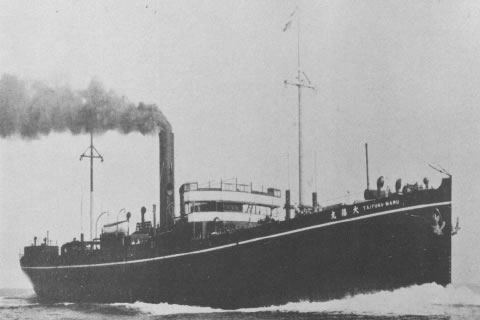
Differences in capabilities between Japan and the world seemed huge at that time. Catching up would take much more than a few years of study. For Kawasaki Dockyard's level of technology to be recognized as first rate, the company had to thoroughly study Western technology and implement it at home. Kojiro did everything he could to make that happen and catch up with the world.





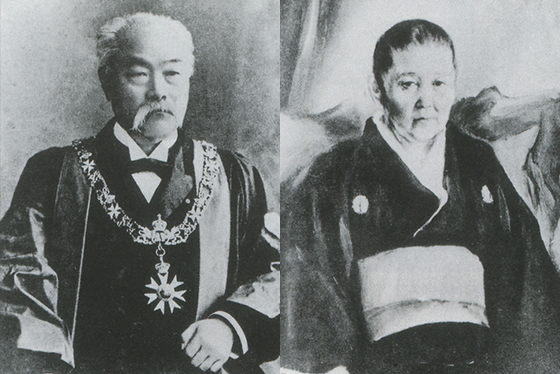
Kojiro Matsukata was born on December 1, 1865, in Satsuma (present-day Kagoshima Prefecture). His father, Masayoshi Matsukata was a politician who served as prime minister twice during the Meiji era. Born to a high-profile family, Kojiro was viewed as a child prodigy by the people around him. However, as a small boy, he was quite mischievous. One anecdote that shows how bold he was happened when he fearlessly jumped from a very high place and cut his Achilles tendon. But he had another side, and was a very diligent man who never failed to train himself, academically and physically. Growing up in Satsuma where men were measured by their bravery, Kojiro became a man of fortitude. He never lost his bold and daring personality. In another anecdote (known as the "stone-filling incident" which happened when he was staying at an inn on his way to Tokyo), Kojiro, unable to sleep because of the snoring of another lodger, filled the lodger's mouth with stones from the garden.
当時の時代背景

The Suez Canal connecting the Mediterranean (Northeastern Egypt) and Red Seas was opened, and transformed global shipping.






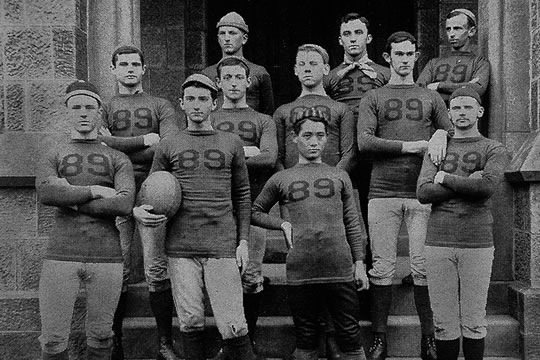
American football team at Rutgers
Kojiro enrolled in the Preparatory School of the University of Tokyo that he had long hoped for, but the school failed to fully satisfy him. Through letters from two brothers who lived outside Japan, he learned of the sophisticated level of education in Europe. Kojiro began thinking, "If I stay in Japan, I will never be competitive in business." Determined to see the world, Kojiro told his father of his desire to study in the United States. He then successfully got into Rutgers College. In the second year, however, he felt that studying at Rutgers was not enough.
Deciding that becoming a diplomat would keep him abreast of world trends, and realizing that Rutgers did not have the faculty of law needed to become a diplomat, he transferred to Yale University. After quickly obtaining a Bachelor's Degree, he continued on to the graduate school, receiving his Master's Degree in the first year and a Doctorate in the second year. He was indeed an outstanding student!
当時の時代背景

The statue, a gift from France in commemoration of the 100th anniversary of the foundation of the United States, was erected in New York. The statue bears a torch in her right hand and a tablet inscribed with the date of the American Declaration of Independence, July 4, 1776, in her left, representing "freedom" and "independence" respectively.






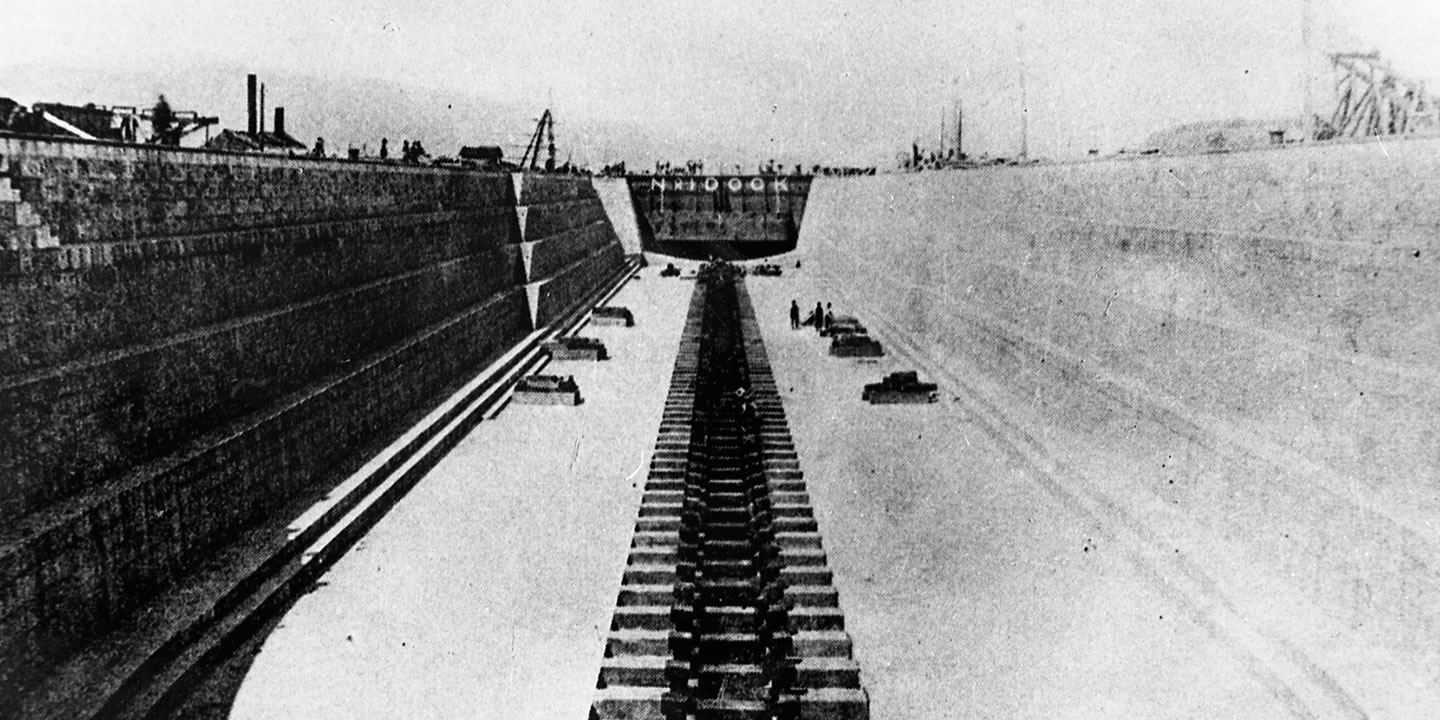
No. 1 Dock at Kobe Works
The founder of Kawasaki Dockyard, Shozo Kawasaki, decided to take the company public in 1894 after realizing the limitations of private management. As the first leader of the business, Kawasaki chose Kojiro, who had returned from his study abroad with a global perspective. After assuming the post, Kojiro’s first project was the construction of a dry dock, which turned out to be unprecedentedly difficult in the history of Japanese shipbuilding. The cause of the challenge was the rock layer.
Initial investigation indicated that the bedrock needed for construction was there, but a second investigation showed different results, and the “bedrock” was found to be only fragments of rocks. It was soft ground and driving in piles made the groundwater spew out. An innovative method was used to construct a dam for draining the water, but it also failed. Feeling responsible, Kojiro made a decision to resign, but it was overturned by Shozo Kawasaki. Encouraged by Kawasaki, Kojiro carried on with the project. After overcoming many other challenges, the dry dock was finally completed in 1902. This was the moment a fervent wish of Kawasaki came true.
当時の時代背景

An international sporting event, the first modern Olympic Games were held in Athens, Greece. The five interlocking rings represent five world continents and the hope for the development of the world toward achieving peace.







The first domestically manufactured steam locomotive
A year after winning the Russo-Japanese War, the Japanese government promulgated the Railway Nationalization Act and purchased 17 private railway companies. The government's justification for this was to strengthen transport capacity under a policy of increasing national prosperity and military power. However, another motive was also at play: to use it as collateral for foreign-currency war bonds and remedy financial difficulties. Kojiro was not going to overlook such an opportunity offered by the state. A short two months after the promulgation of the Railway Nationalization Act, Kojiro decided to expand into rolling stock and constructed a production plant near a canal in Kobe. Four years later, the company successfully produced Japan’s first domestically manufactured steam locomotive, which performed so well that the Rail Bureau wrote to the company saying, "Its outstanding performance is on par with foreign-made locomotives."By 1971, a total of more than 3,000 locomotives were produced at Kawasaki's rolling stock works, which contributed greatly to the popularization of railway transportation in Japan.
当時の時代背景

The war between Japan and Russia began. Fierce battles took place in Manchuria and the Sea of Japan, but eventually the war ended with the signing of the Treaty of Portsmouth, with the intervention of the United States. However, because Japan was not able to receive any compensation for war costs, many revolts occurred which caused public security to deteriorate.






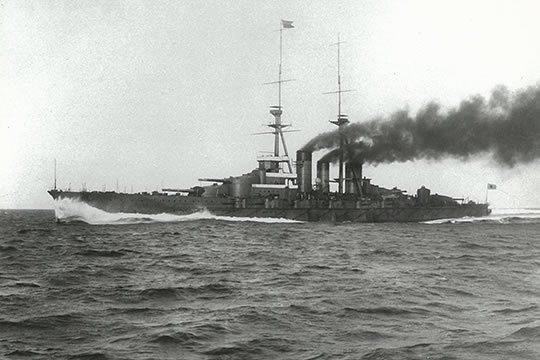
Battle cruiser Haruna
In response to the global expansion of armaments, the Japanese Navy signed a contract with Kawasaki Dockyard to build the super-dreadnought battle cruiser Haruna. However, because the Navy requested delivery in extremely short time, the company underwent a worrisome period, not knowing whether they could meet the deadline, even with an added workforce.While striving to complete the ship, Kojiro noticed that workers at the top of a crane were running the risk of falling. Convinced there could be casualties if they continued working at such a fast pace in a dangerous environment, Kojiro decided to slow the work down and make safety a priority.
This decision was rewarded with an unexpected outcome. As a result of the shorter working hours, higher efficiency was achieved, and the Haruna was completed much earlier than the Navy had anticipated. Western media covered this speedy construction widely, making Kawasaki a force to be reckoned with in the global shipbuilding industry.
当時の時代背景

As a result of the Xinhai Revolution, the Republic of China was established with Sun Yatsen as its Provisional President and Nanjing as its capital, replacing the Qing Dynasty. At this point, however, the Dynasty was still ruling in Beijing, which meant two governments co-existed, one in the south and another in the north. Fierce battles between the two governments followed, with both trying to unify China.







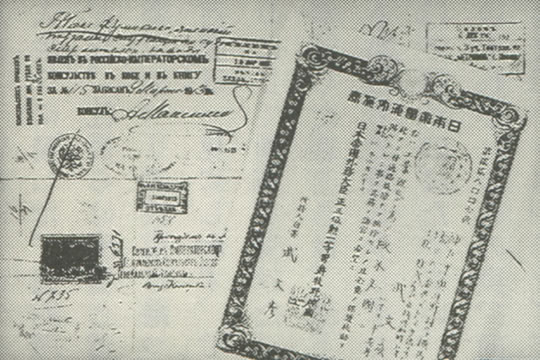
Passports used by Kawasaki Dockyard employees
Differences in capabilities between Japan and the West were obvious to Kojiro. He had a strong desire to make the Kawasaki Dockyard a world-class company, but he knew well that the employee's capabilities were much lower than those of their Western counterparts. Kojiro told management that unless they fully mastered the technology of the West, a breakthrough could not be achieved. He then sent his engineers overseas. Inspired by Western technology, the engineers returned home and became passionate advocates of their newfound knowledge to their peers. Such changes were a testament to Kojiro's belief that, when introduced to something great, the workers would gain a new passion.Through these experiences, Kojiro's framework for human resource development was formed. The sending of employees overseas was followed by a scholarship program, so that the engineers could improve their skills. Kojiro devised a system to allow employees to study at outside institutions after-hours to gain technical expertise, and to receive scholarships if they performed well. The program proved very popular and the quality of work improved. Employees made fewer careless mistakes and worked more efficiently without depending too much on their intuition. Nurtured by Kojiro's creative measures, the employees gradually became world-class engineers.
当時の時代背景

The Panama Canal, located in central Panama, connected the Atlantic and Pacific Oceans. Because of its location, it became an extremely important conduit for transportation and military strategy.






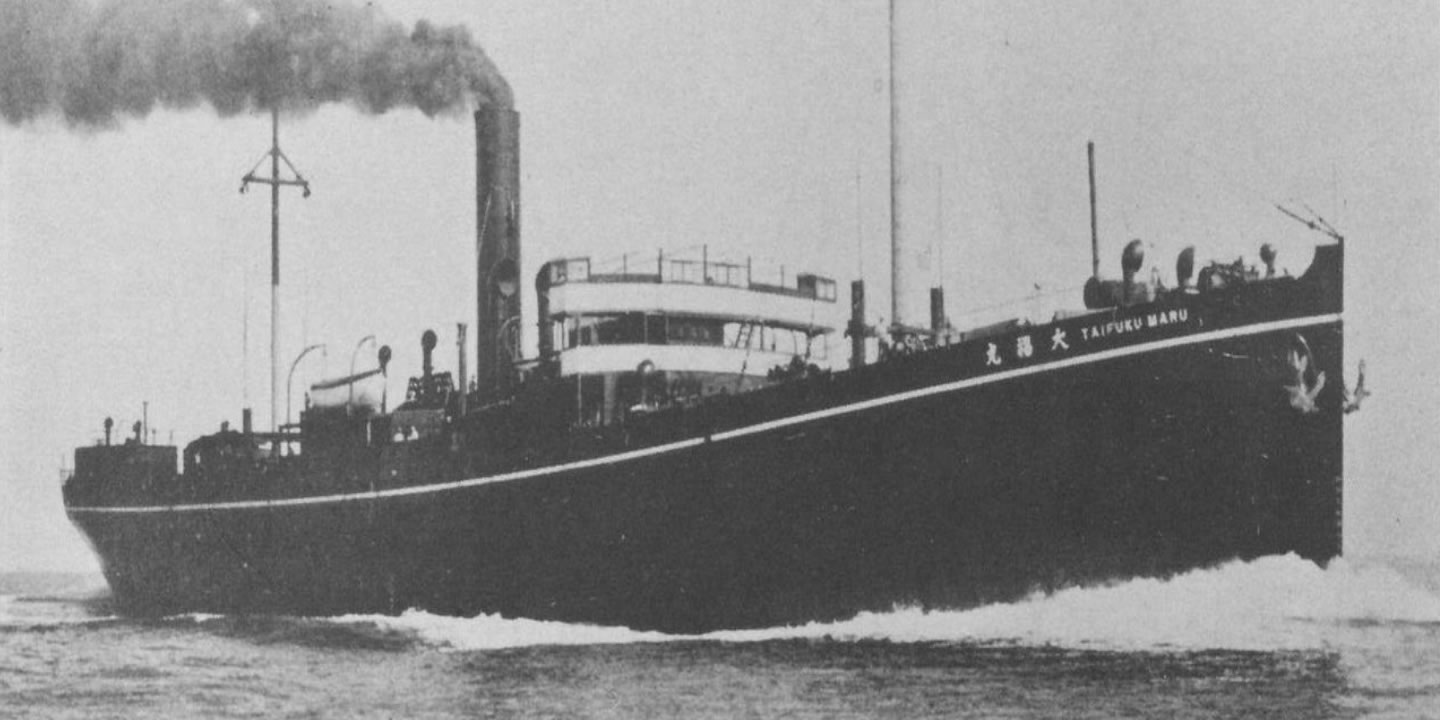
"Stock Boats" generated enormous profits
Daily reading of English newspapers kept Kojiro abreast of developments in the Western world. He predicted that with the outbreak of World War I, sourcing of steel would become difficult. He ordered purchasing managers to buy "everything with the word ‘iron’ in its name." Kojiro also devised an unheard-of shipbuilding business model called "Stock Boats" whereby ships were built with the accumulated iron prior to receiving orders. The plan raised vehement objections at the shareholders meeting, but just as Kojiro had forecast, the company received an avalanche of orders from the Navy immediately following the outbreak of the war.
Although the innovative "Stock Boat" strategy took off very well, and the company expected the business to keep growing, the supply of steel began to dry up, and both Kawasaki and the Navy suffered from the shortage of steel. In the midst of this adversity, Kojiro announced a new plan to construct an ironworks. His thinking was, if steel is not available, the company should produce it, and the new ironworks soon began operation. At the same time, Kojiro negotiated with the U.S. government to resume exports of steel. This was how he ingeniously resolved the steel shortage in Japan.
当時の時代背景

Archduke Franz Ferdinand of Austria and his wife Sophie were assassinated by a young Serb in Sarajevo. This incident led to the outbreak of World War I.







Kawasaki's first aircraft (Type Otsu 1 Surveillance Airplane)
While the world was wondering about the course of WWI, Kojiro was spending time in the United Kingdom. As he was preparing to return to Japan, German long-range bombers raided London. Instead of feeling scared, the first thought that crossed Kojiro's mind was that the "sky" should be the focus of the company's next business. He sent a telegram, ordering his staff to start planning a production site for aviation products. Around the same time, Kojiro established an automobile section in the Machinery Department, after observing the rapid increase of automobile use in the U.S. and Europe. These business diversification strategies were based on his forecast of a post-war recession.
"Overcome adversity without firing employees and stabilize the management base" ― that was Kojiro's approach to management, which shaped the foundation of the company and led to today's high level of international competitiveness.Japan was undergoing rapid changes at that time, but in some respects Kojiro remained unchanged: he continued using a horse-drawn carriage, which had become very rare for regular transportation. Even as other business people began using automobiles, Kojiro preferred commuting in his carriage. This anecdote is still told as an example of his signature determinedness.
当時の時代背景

An armistice was signed between the Germans and the Allies. This treaty virtually ended WWI, and in some countries, the day of the signing is still observed as a memorial day.







A monument marking the birthplace of the eight-hour workday
Price escalation followed the end of WWI, but wages remained unchanged and many people suffered from poverty. Engineers at Kawasaki Dockyard were also affected and they submitted their demands for wage increases many times. Finally, in desperation, they gave the company an ultimatum: they would go on strike unless they got a pay rise. Kojiro remained calm, expressed his appreciation for their work, and announced that the company would pay 10 hours’ worth of daily wages, as usual, but for only eight hours of work. The engineers were at first puzzled, but soon realized that this was an offer of higher wages, and so dropped their demands and threats of a strike.
This implementation of the eight-hour workday had a tremendous impact on the Japanese labor landscape, and the system was quickly adopted across the shipbuilding and steel-making sectors, as well as in other industries throughout Japan.
当時の時代背景

After WWI ended, a peace conference was held to discuss post-war settlements. The signing of the Treaty of Versailles between Germany and the Allies was an important agreement that defined post-war international relations.








Kojiro surrounded by his grandchildren in his final years
In 1941 Kojiro criticized the attack on Pearl Harbor, saying that it was a reckless act. His remarks showed that he was fully aware of the far-reaching production and technological capabilities of the United States and Europe. This, however, became his last outspoken criticism of Japan, which had been his signature style.In 1949, Kojiro fell ill and began to lose strength. On June 24, 1950, he passed away at 84 years and seven-months of age. Many friends and acquaintances crowded his funeral, and, mirroring Kojiro's sanguine disposition, the venue was filled with a hopeful atmosphere throughout the ceremony.
In 1939, the company had been renamed "Kawasaki Heavy Industries, Ltd." and made a fresh start. It expanded further, contributing to Japan's post-war growth, and eventually became what it originally aspired to be ― a global, first-rate corporation.
当時の時代背景

A war broke out between Japan and the Allied Powers (which included the U.S. and the U.K.). In 1945, the war ended with Japan accepting the Potsdam Declaration, calling upon the government of Japan to proclaim unconditional surrender.









